
Deliver immediate Project Visibility and Production Operations Coordination
The ConstructOps Command Post is an AI-defined construction field trailer that brings real-time project coordination and operational insights directly to the heart of construction sites.
Modeled after Palantir’s groundbreaking Titan project, this next-generation facility combines the power of Artificial Intelligence (AI) and Machine Learning (ML) to enhance safety, productivity, and collaboration.
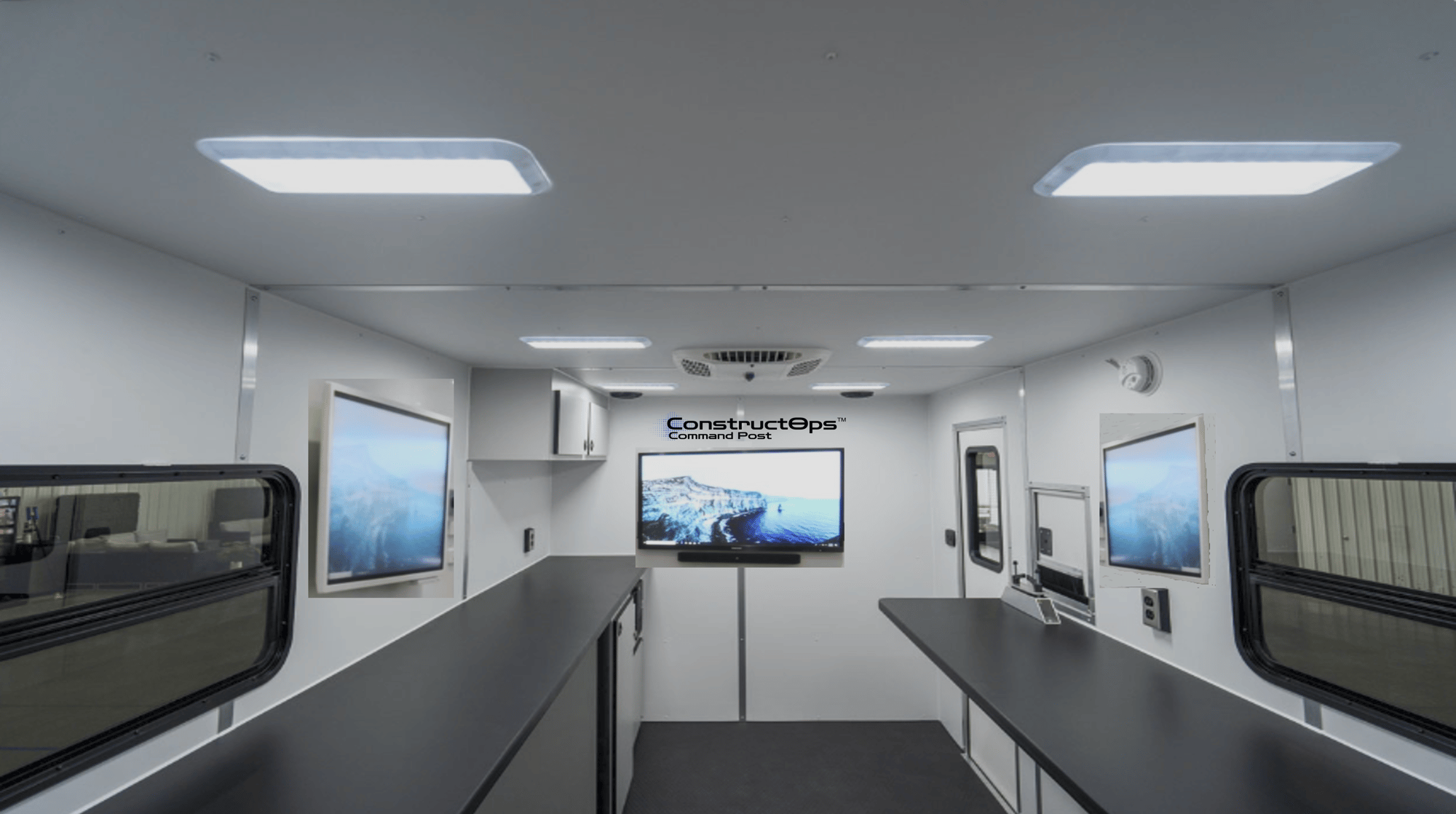

Key Features and Benefits
Real-Time Telemetry Insights:
The ConstructOps Command Post provides immediate visibility into project progress, safety compliance, and resource allocation. Real-time data streams from sensors, drones, and other sources empower project managers to make informed decisions on the spot.- Safety Monitoring: Receive instant alerts for potential hazards, ensuring a safer work environment for all personnel.
- Productivity Insights: Track work progress, identify bottlenecks, and optimize resource allocation for maximum efficiency.
- Quality Assurance and Compliance: Monitor adherence to quality standards and regulatory requirements, reducing costly rework.
- Collaboration and Knowledge Sharing: Facilitate seamless communication among teams, subcontractors, and stakeholders.
AI-Driven Decision Support:
Our AI algorithms analyze data from various sources, including construction equipment, environmental sensors, and project documentation.- Predictive Analytics: Anticipate delays, material shortages, or other issues before they impact project timelines.
- Resource Optimization: Allocate labor, machinery, and materials effectively based on real-time demand.
- Risk Mitigation: Identify potential risks early and implement preventive measures.
Seamless Integration:
Connects with existing project management tools, BIM (Building Information Modeling) software, and other industry systems.
- Interoperability: Share data with subcontractors, architects, and regulatory agencies seamlessly.
- Drone Port: Dock drones for aerial surveys, site mapping, and progress visualization.
Mobile and Modular Design:
The ConstructOps Command Post is built for mobility. It can be easily transported to different project sites, adapting to changing needs.- All-Aluminum Construction: Lightweight, durable, and corrosion-resistant. It withstands the rigors of construction environments.
- Telescopic Camera System: Capture high-resolution images and videos for documentation, progress tracking, and remote inspections.
Security:
In the evening, our cutting-edge security measures at the construction site include infrared imaging and immediate drone deployment. These technologies, along with other advanced sensors, enhance safety and vigilance. Here’s how they benefit our project:
- Immediate Drone Availability:
-
- Real-time Surveillance: Drones equipped with high-resolution cameras and thermal sensors allow us to monitor construction progress and ensure quality control. They identify defects, safety hazards, and discrepancies in real time.
- Efficient Communication: Our executives receive timely updates without leaving their offices. A drone fly-through of the site during safety briefings creates impactful visuals for workers, promoting safety awareness.
- Infrared Imaging:
-
- Detects Temperature Variations: Equipped with thermal cameras, our drones identify temperature differences in building structures. This helps us pinpoint potential issues with insulation, locate areas of heat loss, and even detect water infiltration.
- Enhances Building Inspections: By providing up-to-date and accurate data, infrared imaging streamlines inspections. Within minutes, we can relay critical information to architects and clients, eliminating the need for physical site visits and lengthy reports.
These measures not only enhance security but also contribute to efficient project production management.
Industry Impact
The ConstructOps Command Post empowers construction teams to work smarter, safer, and more efficiently. Imagine project managers analyzing real-time data on their tablets while standing amidst the construction hustle. With BuilderChain’s AI-defined field trailer, the future of construction is here.
Whether you’re overseeing a high-rise building, a highway expansion, or a residential development, the ConstructOps Command Post ensures that every nail hammered, every beam lifted, and every concrete pour contributes to a successful project outcome.
Welcome to the era of intelligent construction.
Welcome to the BuilderChain ConstructOps Command Post!
Learn more about ConstructOps Tools and explore our ready-to-deploy templates here.1
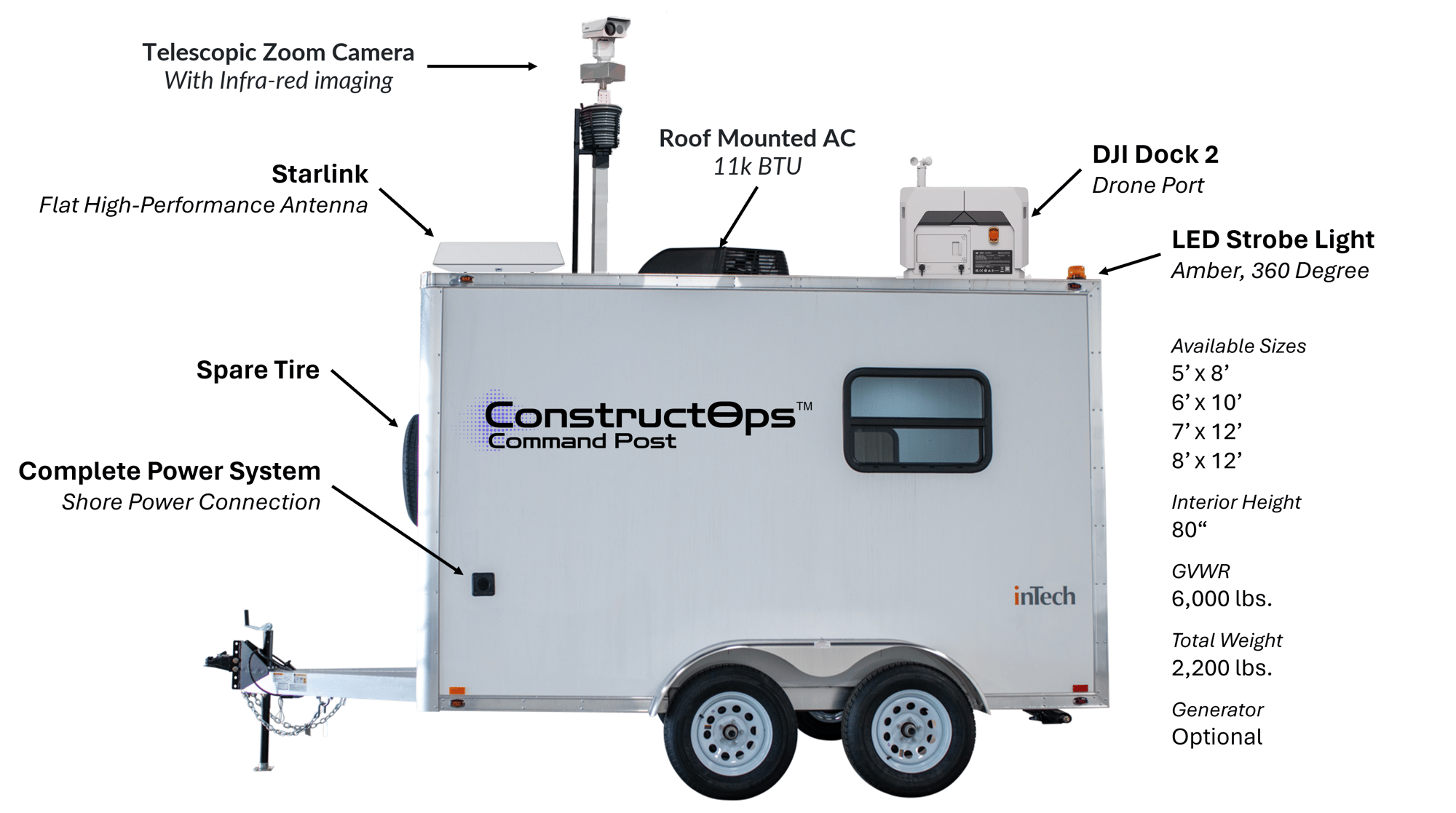

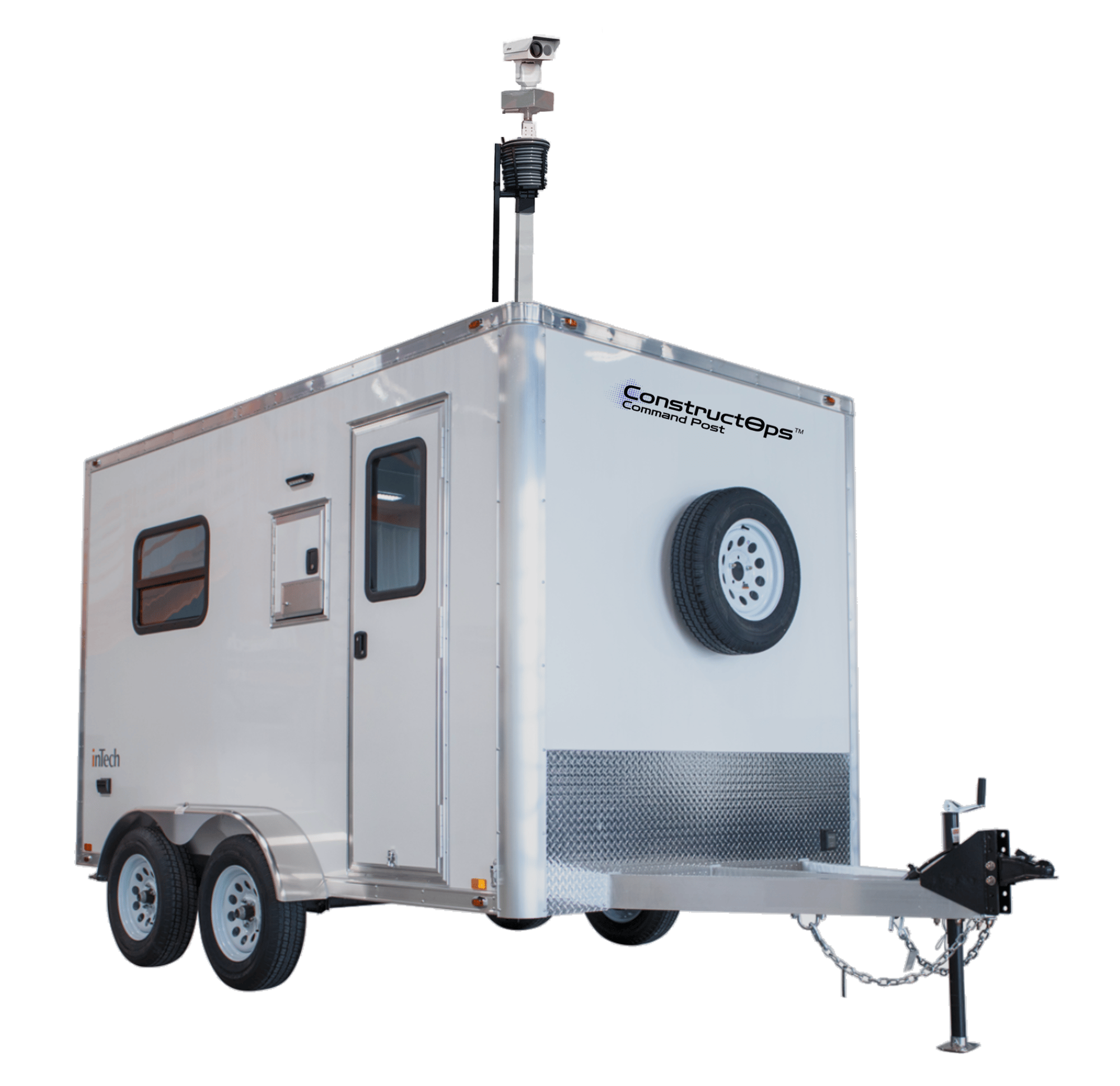

ConstructOps Drone Port
6 Ways Drones Benefit Construction Projects
Here are six ways that drones for construction inspection and drone construction inspection are revolutionizing the field.
| Improved Safety | Tired of sweating it out on wobbly ladders or dangling from heights? By deploying drones for construction inspection, the need for manual labor in hazardous situations can be minimized. Drones can easily access hard-to-reach or dangerous locations, such as rooftops, bridges, or power lines, reducing the risk of accidents for workers. |
| Increased Efficiency | Drones can cover large areas in a fraction of the time it takes for manual inspections, cutting down on project timelines. Drone construction inspection allows for rapid data collection and analysis, which can help with decision-making and overall project efficiency. |
| Enhanced Accuracy | Drones are equipped with high-resolution cameras and advanced sensors that capture detailed and precise data. This allows for accurate measurements and comprehensive inspections. Drone inspection of facilities is more reliable than traditional methods, leading to better quality control. |
| Cost-Effective | In the long run, the use of drones for construction inspection can be a cost-effective alternative to traditional methods. Drones reduce the need for expensive equipment, such as cranes or scaffolding, and help to avoid potential accidents that could lead to costly legal battles or project delays. |
| Remote Access | Drone construction inspection enables remote access to sites, eliminating the need for on-site presence. This is particularly useful for inspecting facilities located in challenging environments or areas with restricted access. Inspectors can easily monitor and analyze sites from the comfort of their offices, saving time and resources. |
| Advanced Reporting | Drones provide real-time data that can be easily shared with project stakeholders. Advanced reporting options, such as 3D modeling, thermal imaging, and orthomosaic maps, offer valuable insights into project progress and potential issues. Drone inspection of facilities can provide detailed documentation for compliance purposes or future reference. |
10 Applications of Drones in Construction and Site Inspection
Here's how drones are being used in construction and inspection:
| Site Surveying | Drones for construction inspection allow you to quickly survey a site, gathering accurate data to create 3D models or topographic maps. This data can be used for site planning, design, and management. |
| Building Inspections | Want to inspect that hard-to-reach spot on the rooftop? No need for a ladder or scaffolding. Just send up a drone and get all the details you need without breaking a sweat. Plus, it saves time and avoids the risks of accidents. |
| Progress Monitoring | Drones can provide real-time updates on construction progress, making it easier for project managers to monitor workflows, allocate resources efficiently, and make informed decisions. |
| Thermal Imaging | Some of the best drones for building inspection come equipped with thermal imaging cameras. These are particularly useful for detecting issues related to insulation, water leaks, or electrical problems. |
| Structural Inspections | Inspecting large structures like bridges, dams, or towers has never been easier. Drones provide high-resolution images and videos to catch structural issues or wear and tear. |
| Safety Compliance | Drones can be used to monitor a construction site for safety compliance, ensuring that all safety protocols are being followed and identifying potential hazards. |
| Volumetric Analysis | Need to measure huge amounts of materials on a site? Drones with LiDAR or photogrammetry come in to analyze the volumes of materials on construction sites, such as earthworks or stockpiles. |
| As-Built Surveys | Once your project is done, drones can do a final sweep to provide data for facility management and future maintenance. |
| Risk Assessment | By providing an aerial perspective of a construction site, drones can assist in identifying potential risks and planning for risk mitigation. |
| Documentation | Drones can capture high-quality images and videos of a construction project, which can be used for marketing purposes, client updates, or project documentation. |
9 Ways Drones Benefit Building Inspection
Drones have revolutionized building inspections by offering unparalleled aerial perspectives. Equipped with high-resolution cameras and thermal imaging capabilities, a building drone can detect structural flaws, moisture intrusion, and thermal inefficiencies with precision. Here are nine ways drones can benefit building inspection:
| Cost Savings | Ever had to fork over a ton of money to rent scaffolding or lift equipment for a building inspection? Well, not anymore. Such traditional access methods are often expensive and time-consuming. Drones can reach dizzying heights and tight spaces without the need for pricey gear, making the process way more affordable. |
| Speed and Efficiency | Compared to manual inspections, their speed is unmatched. Human inspectors would need ladders, ropes, and possibly a few cups of coffee to get to some of these spots. Drones, on the other hand, can be fired up in under a minute, zip cover large areas and reach high sections with ease, minimizing downtime and disruption for occupants. Everybody wins! |
| Safe and Sound | Climbing ladders or navigating damaged structures can be risky for human inspectors. Drones, though? No problem! Whether it's a precarious rooftop or a crumbling facade, drones can safely go where humans fear to tread, making the inspection process much safer for everyone involved. |
| High-Quality Imagery | Equipped with high-resolution and zoom cameras drones can capture images so detailed you'll feel like you're standing right there. They even go further to beyond what is detectable by the naked eye, courtesy of their thermal imaging capabilities. Inspectors can use these crisp photos to spot potential issues, from tiny cracks to sneaky leaks. |
| Data Accuracy | When it comes to building inspections, accuracy is key. Drones can provide precise measurements and geo-referenced data. Work with integrated software, you can create 3D models and maps - which are invaluable for assessing structural integrity and planning maintenance or repairs. Using this data with Building Information Modeling (BIM) systems, inspectors can obtain detailed visual overlays, enhancing the accuracy of assessments. |
| Thermal Imaging | Areas of heat loss, insulation gaps, and water leaks – such issues are difficult to spot, especially early on with the naked eye. But that's easy with drones with thermal cams. This helps you to improve energy efficiency and reduce the risk of mold or structural damage. |
| Historical Data | Conducting drone inspections periodically allows you to create a historical record of a building's condition over time. This heap of data lets you track changes, spot trends, and plan future maintenance. It can also be beneficial for property owners looking to sell or lease their buildings. |
| Accessibility | Drones can easily access areas that may be difficult or impossible for human inspectors to reach, such as narrow gaps, high ledges, or areas obscured by vegetation. Drones can easily access them, ensuring every nook and cranny gets the attention it deserves. |
| Preventive Maintenance | Drones can spot potential issues early on, helping you nip problems in the bud before they snowball into costly repairs. In that way, regular inspections contribute to extending the building's lifespan. |
8 Applications For Building Inspection Drones
| Rooftop Inspection | Instead of risking injury by sending a human onto a rooftop, drones can easily capture high-resolution images of roofs to identify leaks, structural issues, or other problems. |
| Building Facades | With drones, inspectors can easily access and analyze all sides of a building, including hard-to-reach areas. Issues such as cracks, leaks, or structural problems can quickly be detected. |
| Thermal Imaging | Drones equipped with thermal cameras can identify temperature differences in a building's structure, helping to pinpoint areas of energy loss, leaks, or other potential issues. |
| Structural Assessment | Drones can assess a building's structural integrity by capturing images of the foundation, walls, and support structures. Inspectors, on- and off-site engineers can then use this to see any potential issues or areas of concern. |
| Disaster Assessment | In the aftermath of a natural disaster, drones can quickly and safely assess the extent of damage to a building. That way you can determine if the building is safe for occupation or if immediate repairs are needed. |
| Site Mapping and Planning | Survey drones can capture images of a construction site from different angles, helping to create a comprehensive site map. Such data is useful for both the planning stage and monitoring construction progress. |
| Historic Preservation | When inspecting historic buildings, drones offer a non-invasive way to capture images of delicate structures without causing further damage. |
| Building Envelope Inspection | What's a quick and effective way of finding out if a building is well-insulated and energy-efficient? Use a drone to inspect its exterior envelope for water intrusion, air leaks, or other issues. |
10 Ways Drones Benefit Industrial Inspection
| No Hard Hats Needed – Drones Make Inspections Safer | The safety of inspection personnel is paramount, and industrial drone inspection addresses this concern. The drones can access hard-to-reach and hazardous areas, eliminating the risk of accidents and injuries. |
| Cut Costs, Not Corners | Using drones can lead to substantial cost savings. Inspections are done more quickly and with fewer personnel than traditional methods, leading to fewer resources being spent on your operations. |
| Efficiency – Beat the Clock | Drones can cover large areas in a short amount of time, which is significantly more efficient than human inspectors who may need days or even weeks to inspect the same area. |
| Accuracy – Get the Full Picture | Our drones are equipped with high-resolution cameras and sensors to capture detailed images and data. This ensures accurate and thorough inspections that can identify even minor issues that might be missed by the naked eye. |
| Data Analysis | Drones that come with advanced thermal imaging, infrared, and LiDAR sensors give you tools for in-depth data analysis. These technologies can uncover problems that go unnoticed in regular visual inspections. |
| Real-time Monitoring for Instant Insights | The ability to transmit data and images in real-time is invaluable. Drones for industrial inspections can provide immediate insights, allowing for quick assessment and decision-making. |
| Reduced Downtime | Faster inspections mean less downtime for equipment and facilities, minimizing disruption to operations and production schedules – which translates to even more savings and higher productivity. |
| Predictive Maintenance Keeps You One Step Ahead | Using UAV industrial inspection drones, you can identify potential problems before they escalate. That way you can carry out proactive maintenance, reduce the risk of costly breakdowns, and extend the lifespan of equipment. |
| Digital Records | Drone inspections generate digital records that can be easily stored, shared, and analyzed for trends. This information is crucial for future maintenance plans and managing assets. |
| Green Inspections | Drones for industrial inspections can access remote or environmentally sensitive areas without disturbing the surrounding ecosystem. This minimizes the impact of inspections and keeps your operations compliant with environmental regulations. |

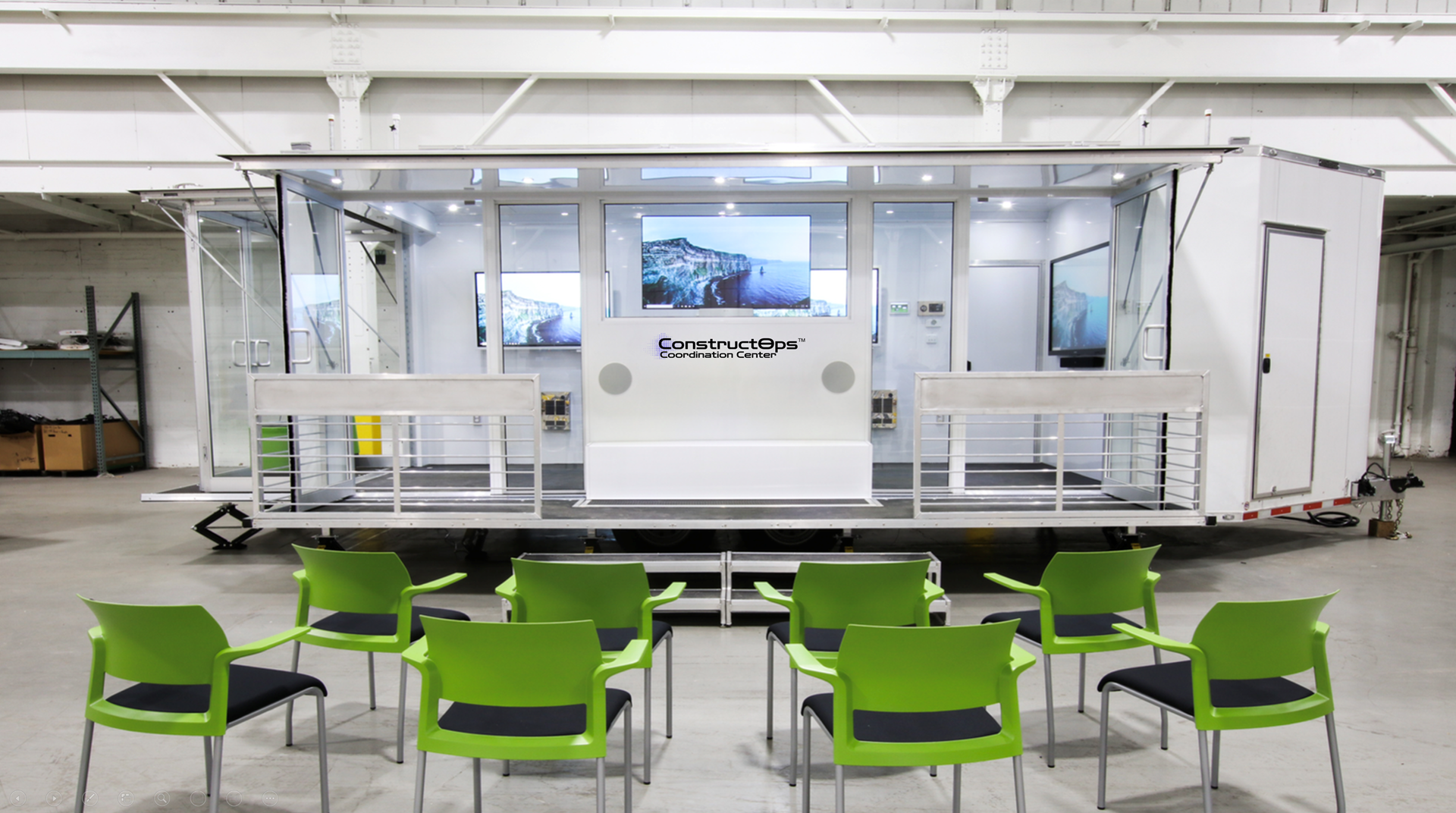
Take your construction project coordination meetings to a new level. Digital presentations can be made from exterior seating when warranted.
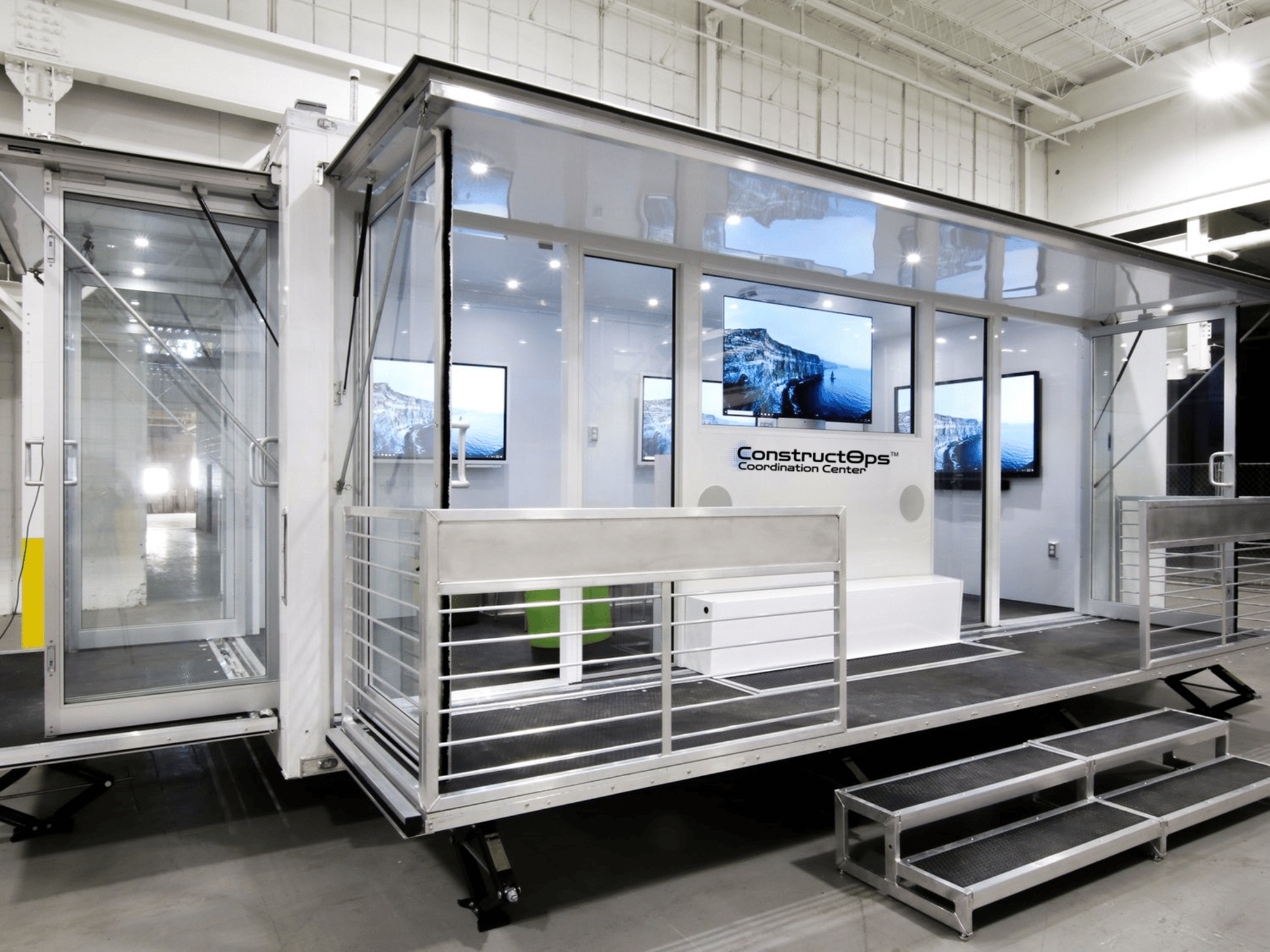
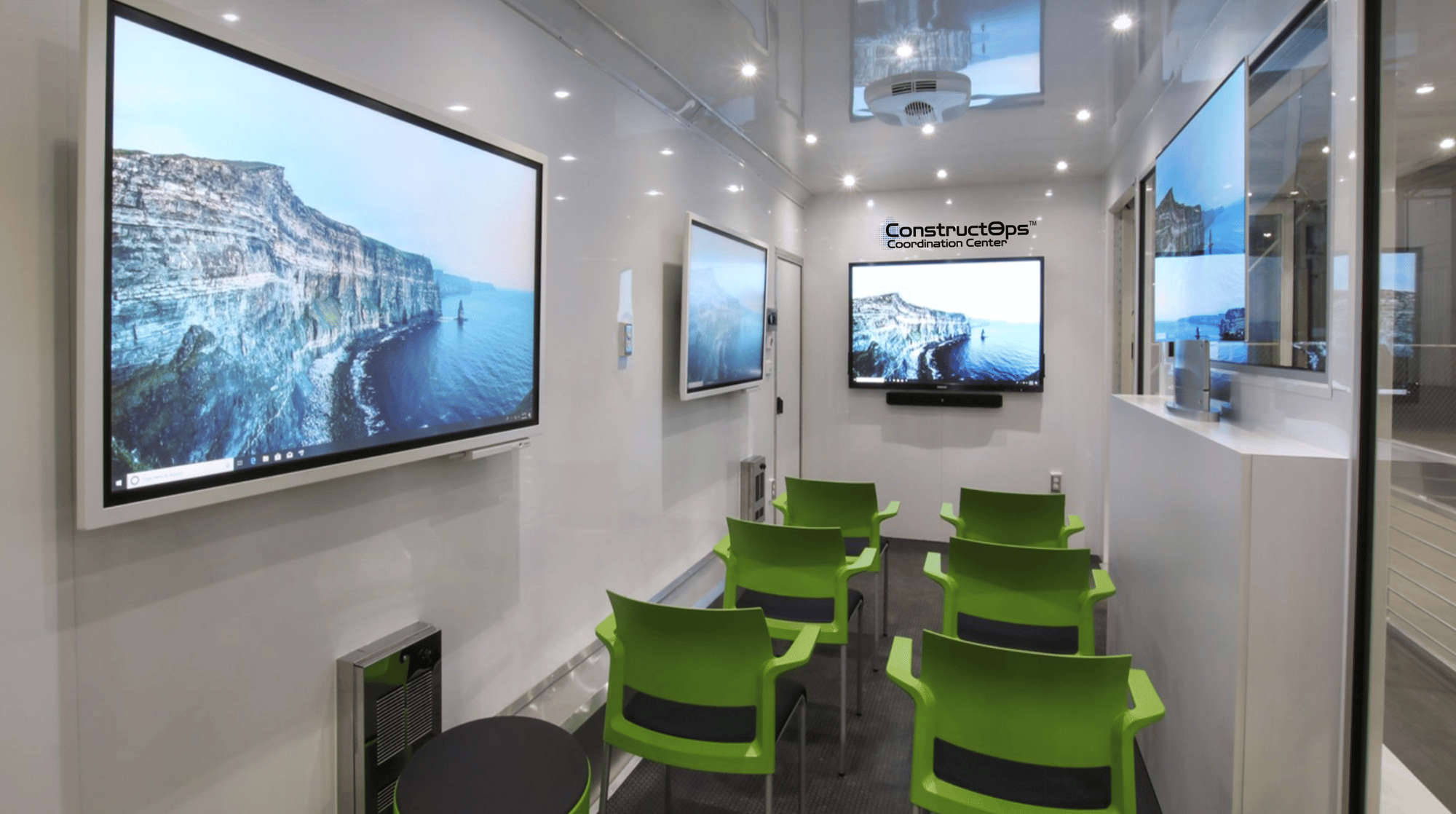
Interior seating for coordination meetings can also be accommodated.
Our Command Post Field Trailer is part of a Network Edge Device Telemetry Strategy
To achieve optimum Construction operations goals, real-time telemetry must be collected effectively from the construction site. The ConstructOps Command Post field trailer, along with our ConstructOps Human Telemetry Pendent are designed to do exactly that in the most effective way possible.

